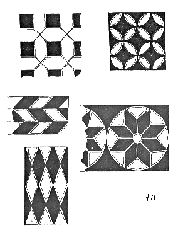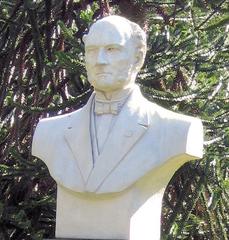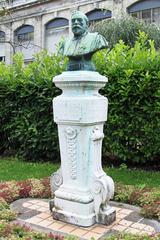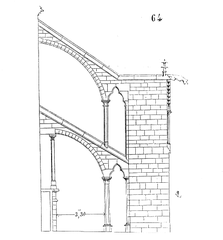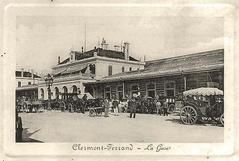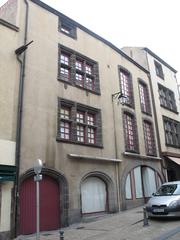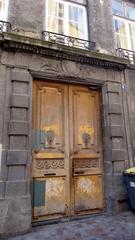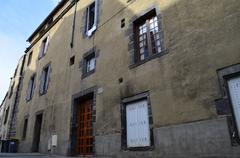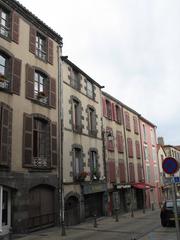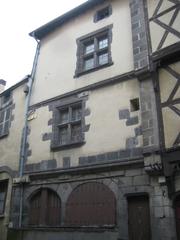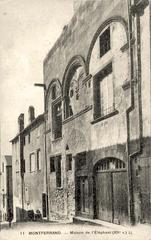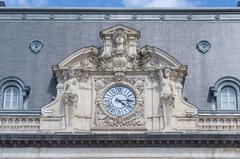Immeuble Chabert Clermont-Ferrand: Visiting Hours, Tickets, and Historical Site Guide
Date: 14/06/2025
Introduction: Immeuble Chabert and Its Significance
Immeuble Chabert, located in the heart of Clermont-Ferrand, stands as a distinguished testament to the city’s architectural evolution and rich cultural history. With its blend of Art Nouveau and Art Deco influences, the building exemplifies the transition from turn-of-the-century craftsmanship to the modernist aspirations of the 1930s. Recognized as a protected Monument Historique by the French Ministry of Culture, Immeuble Chabert not only embodies the creative ambitions of its era but also plays a vital role in Clermont-Ferrand’s urban identity (Monumentum, Monumentum).
While the building is primarily a private residence, its striking façade and prime location at both 10 rue de Ceyrat and 36 avenue Julien make it a must-see for visitors interested in architecture, history, and the broader narrative of Clermont-Ferrand’s development. This guide provides a detailed overview of Immeuble Chabert’s history, architectural features, visiting information, and cultural context, equipping travelers to fully appreciate this unique landmark (Clermont Auvergne Volcans, Clermont Auvergne Tourisme).
Historical Background
Early 20th-Century Urban Development
At the dawn of the 20th century, Clermont-Ferrand was undergoing significant transformation. The construction of Immeuble Chabert in 1905 epitomizes this shift, reflecting the city’s move towards architectural innovation and the embrace of modern styles (Monumentum). The building’s commission by Louis Delamas, a prominent local architect, signaled the rising ambitions of the city’s bourgeoisie, particularly those connected with the burgeoning Michelin industry.
Architectural Context and Influences
Immeuble Chabert’s design is rooted in Art Nouveau, characterized by organic forms, undulating stonework, and intricate ironwork, visible in its façade and decorative details. In the 1930s, architect Pincot’s addition of a third floor and the later Art Deco Immeuble Chabert at 36 avenue Julien, designed by Marius Lanquette, introduced geometric forms and a metal framework, further enhancing the building’s architectural legacy (Monumentum, Wikipatrimoine).
Social and Cultural Significance
Set amidst a district known for its architectural variety, Immeuble Chabert bridges Clermont-Ferrand’s medieval roots and its Belle Époque modernization. Its construction during a period of economic growth reflects the aspirations of the city’s professional and industrial classes (Monumentum).
Heritage Recognition and Protection
Monument Historique Status
Immeuble Chabert was designated a Monument Historique in 1986, a recognition that ensures the preservation and careful stewardship of its façades, roofs, and entrance vestibule (Monumentum). The building at 36 avenue Julien received similar protection in 2002, emphasizing the significance of its Art Deco features (Monumentum).
Conservation Efforts
Ongoing conservation ensures that Immeuble Chabert retains its historical integrity while adapting to modern residential needs. As a private property, interior access is limited, but its exterior remains an essential element of Clermont-Ferrand’s urban landscape.
Visiting Immeuble Chabert: Practical Information
Can Visitors Access Immeuble Chabert?
Immeuble Chabert is primarily a private residence, so regular interior visits are not available. However, its exterior can be admired year-round from the street, offering ample opportunity for photography and architectural observation.
Visiting Hours and Tickets
- General Public: The building’s exterior is viewable at any time. There are no regular interior visiting hours.
- Special Access: During events such as the European Heritage Days (Journées Européennes du Patrimoine), guided tours may grant interior access. Check with Clermont Auvergne Tourisme for details.
Accessibility and Travel Tips
- Location: Both 10 rue de Ceyrat and 36 avenue Julien are centrally located and easily accessible via public transit, with nearby tram and bus stops.
- Parking: Public garages are available at Place de Jaude and nearby squares.
- Accessibility: The building’s exterior is accessible at street level, though some surrounding cobbled streets may challenge wheelchair users.
Nearby Attractions
Consider combining your visit to Immeuble Chabert with other local highlights:
- Cathédrale Notre-Dame-de-l’Assomption
- Basilica of Notre-Dame-du-Port
- Place de Jaude
- Hôtel Regin
- Jardin Lecoq
For more details, use digital maps or the Clermont Auvergne Volcans Tourist Office.
Special Events and Guided Tours
During the annual Journées Européennes du Patrimoine and select local heritage events, Immeuble Chabert is sometimes included in guided tours. Advance booking is recommended as spots are limited.
Architectural Significance and Structural Innovation
Both Art Nouveau (10 rue de Ceyrat) and Art Deco (36 avenue Julien) iterations of Immeuble Chabert are celebrated for their design and engineering:
- Art Nouveau Features: Flowing lines, sculpted stone, elaborate ironwork, and custom woodwork.
- Art Deco Features: Geometric forms, metal framework, loggias, balconies, fluted pilasters, and stylized floral motifs.
- Structural Innovation: The use of metal frameworks allowed for flexible layouts and enhanced natural light (Monumentum, Wikipatrimoine).
Technical Data
- 10 rue de Ceyrat: Built 1905, architect Louis Delamas.
- 36 avenue Julien: Built 1928–1933, architect Marius Lanquette, 8 above-ground levels, metal framework with stone facades (PSS-Archi).
Frequently Asked Questions (FAQ)
Q: Can I visit the inside of Immeuble Chabert?
A: Interior access is generally restricted, but the exterior can be viewed anytime. Guided tours may be available during special events.
Q: Are there any entrance fees?
A: There is no charge to view the exterior; guided tours during special events may require booking.
Q: Is the building wheelchair accessible?
A: The exterior is accessible, though the surrounding area includes cobblestone streets.
Q: Where can I find more information or book guided tours?
A: Visit the Clermont Auvergne Tourisme website for the latest updates.
Visuals and Media
For high-quality images and virtual tours, visit:
Include alt text such as “Immeuble Chabert façade with Art Nouveau ironwork” for accessibility and SEO.
Visitor Tips
- Best Time to Visit: Late spring and early summer offer pleasant weather, but rain is common in June—bring appropriate gear (whereandwhen.net).
- Footwear: Wear comfortable shoes; surfaces may be slippery.
- Language: Tourist information is available in French and English.
- Local Dining: Sample Auvergne cuisine at nearby restaurants.
- Souvenirs: The Maison du Tourisme offers local products and crafts.
Cultural and Community Value
Immeuble Chabert symbolizes the intersection of Clermont-Ferrand’s architectural tradition, community pride, and commitment to heritage preservation (Actuacity). Its continued maintenance and inclusion in cultural events highlight its role as a touchstone for both locals and visitors.
Integration with Clermont-Ferrand’s Broader Heritage
Visitors are encouraged to explore Immeuble Chabert as part of a larger journey through Clermont-Ferrand’s historic center, which features Romanesque churches, volcanic stone architecture, and vibrant markets (The Good Life France, Adventure Backpack).
Plan Your Visit
For a richer experience, consider the following:
- Schedule your visit during the European Heritage Days for guided access.
- Refer to official tourism websites for up-to-date information and event schedules.
Further Resources
- Monumentum - Immeuble Chabert 10 rue de Ceyrat
- Monumentum - Immeuble Chabert 36 avenue Julien
- Wikipatrimoine
- Clermont Auvergne Tourisme
- Clermont Auvergne Volcans
- The Good Life France
- Adventure Backpack
- Actuacity
- Wanderlog
- PSS-Archi
- ClermontFerrand.net
